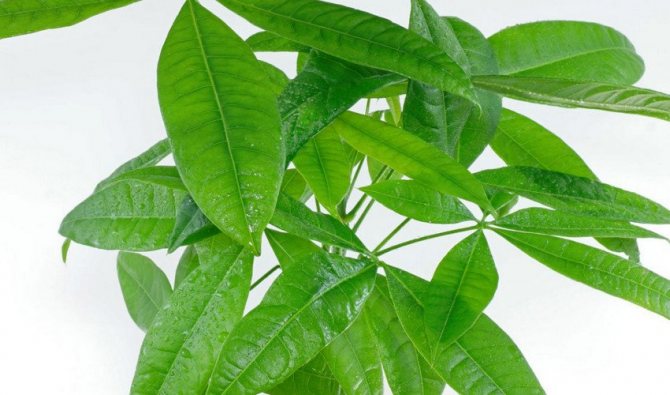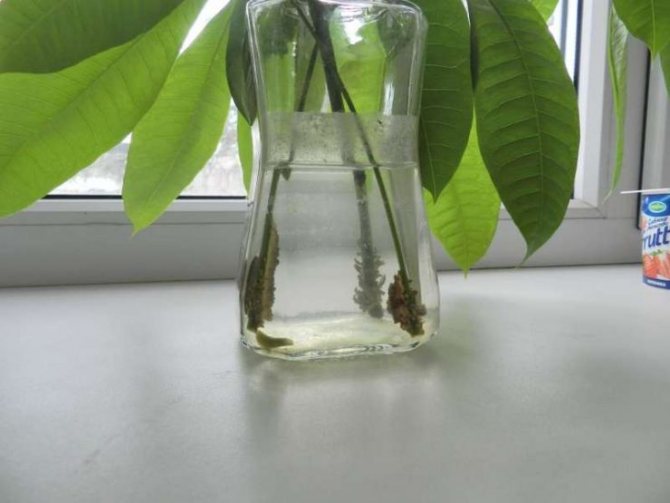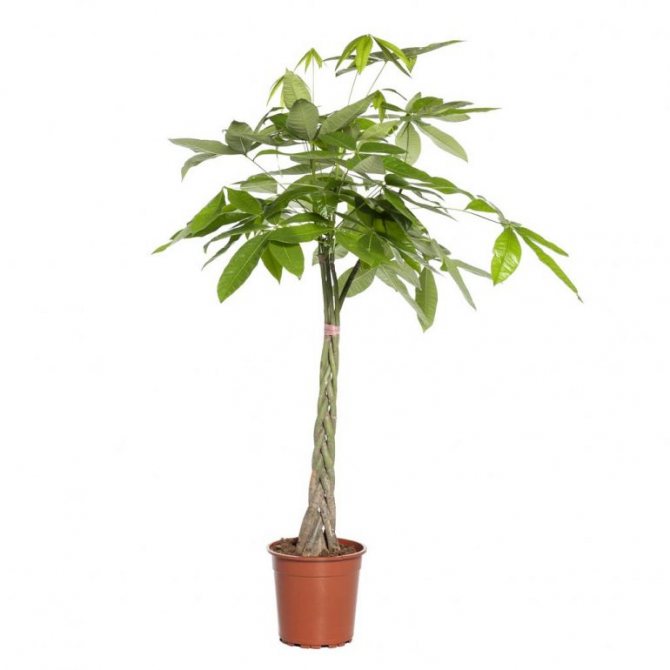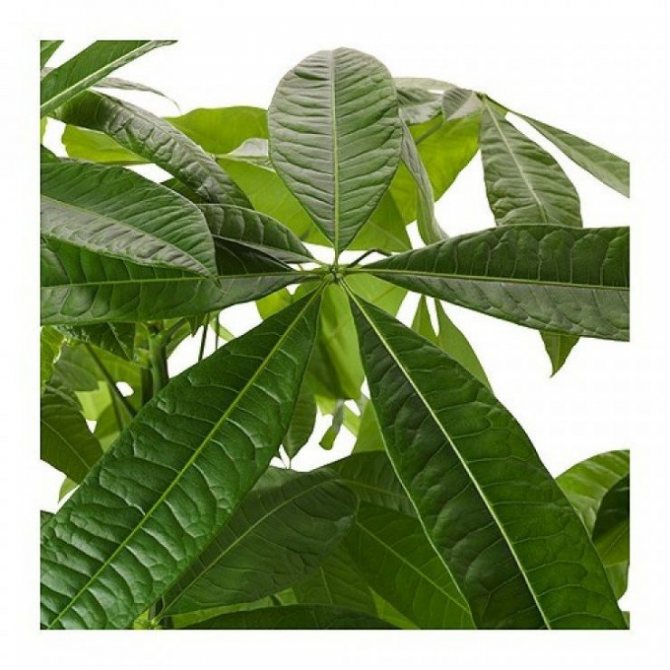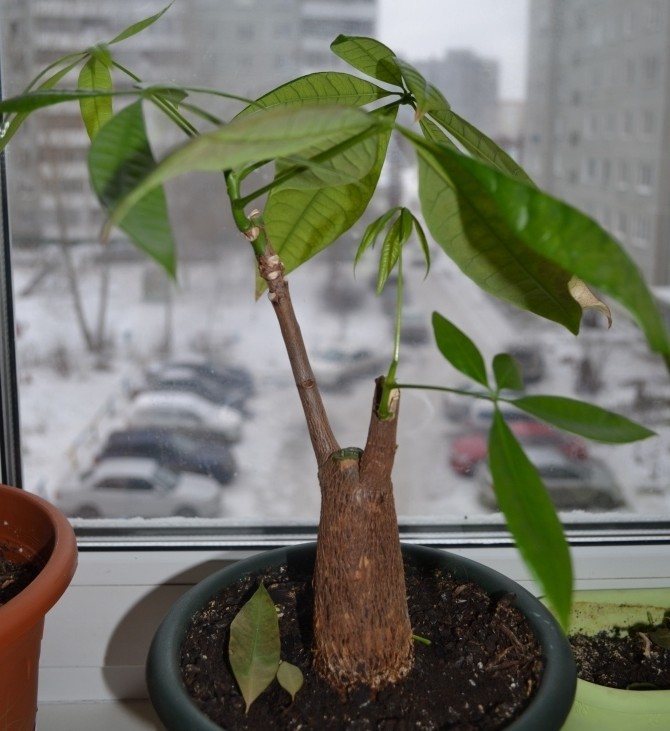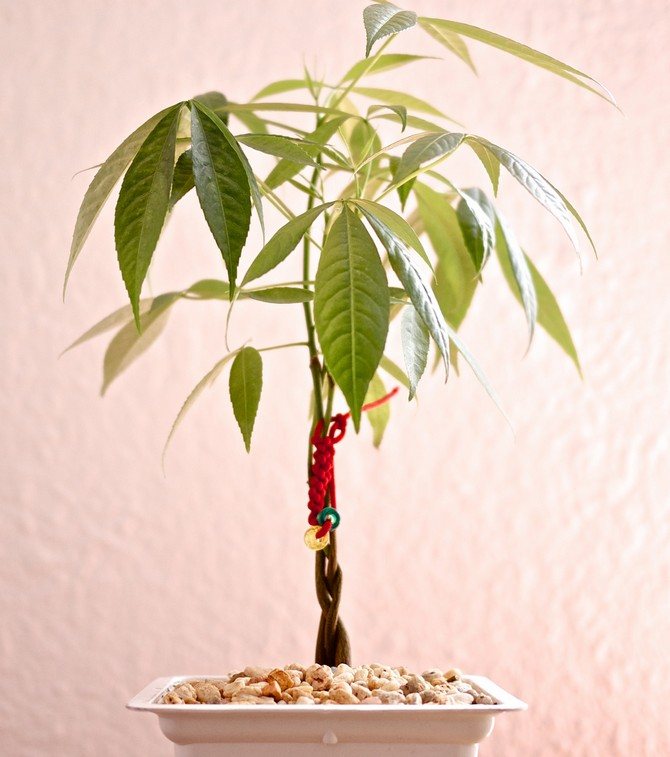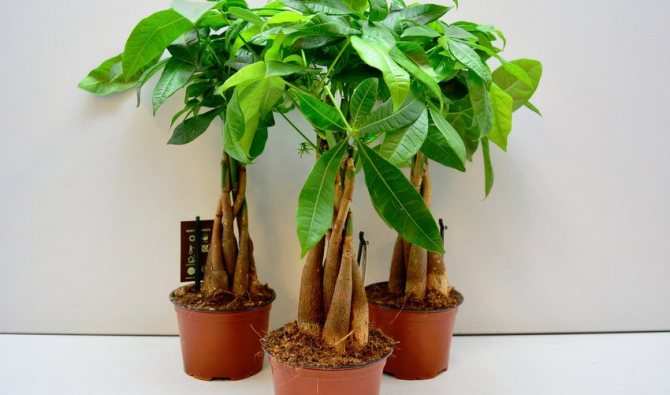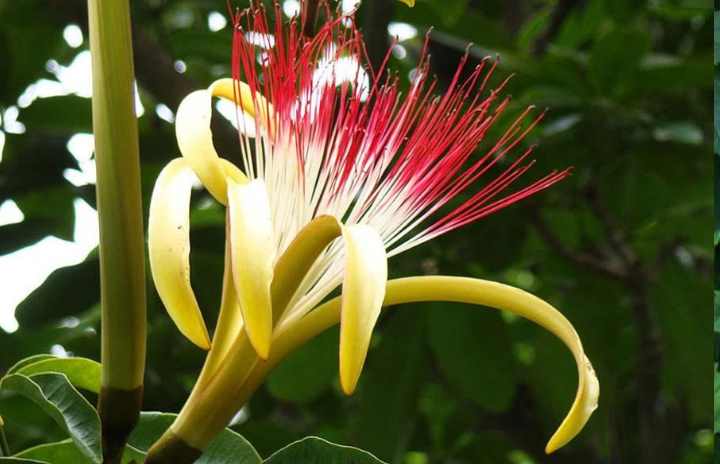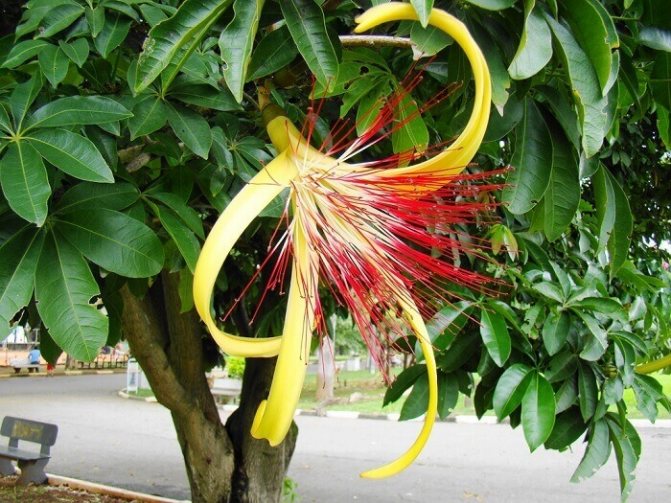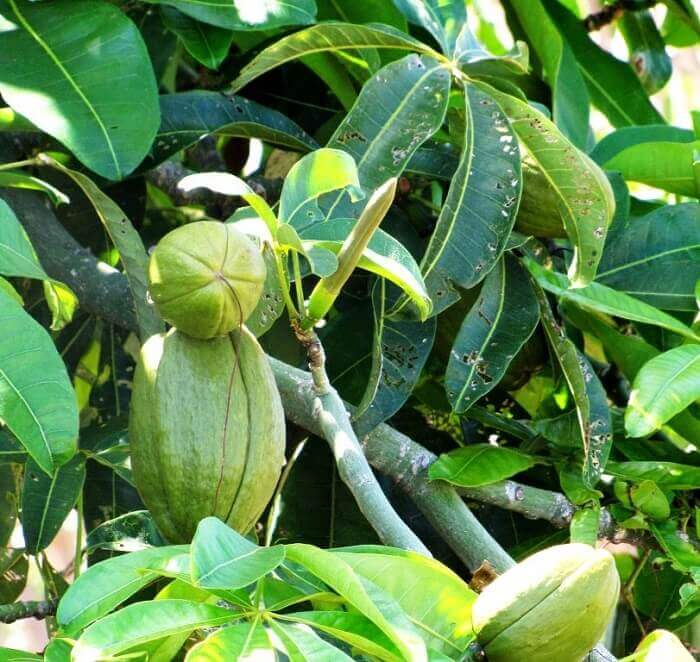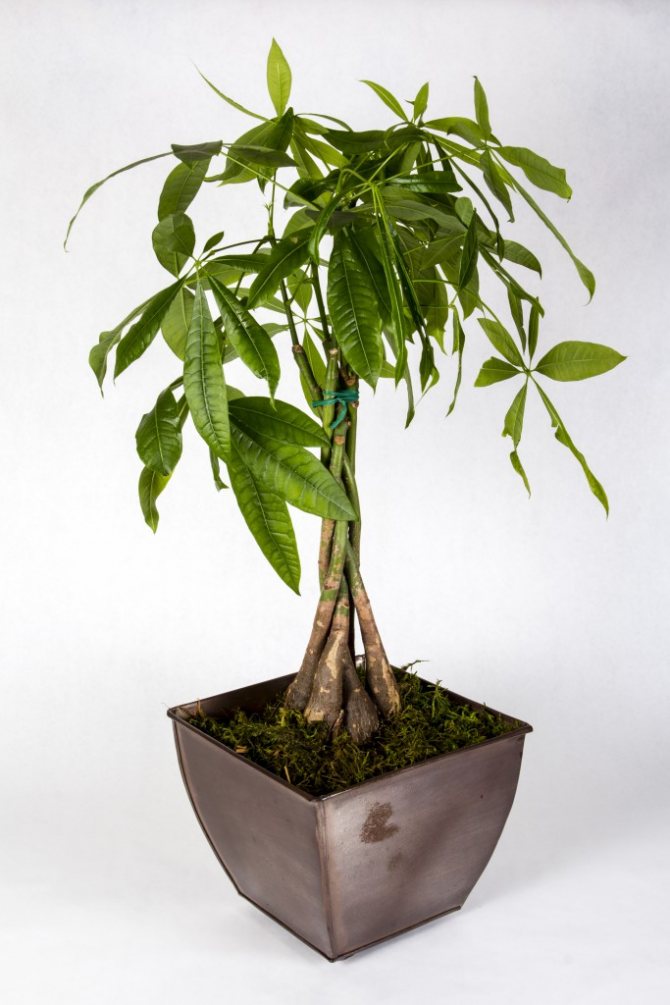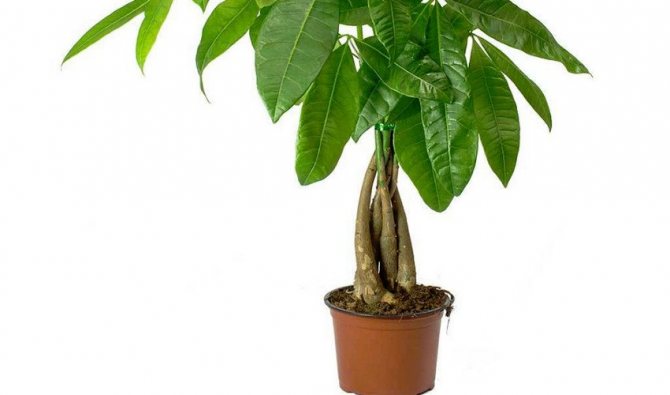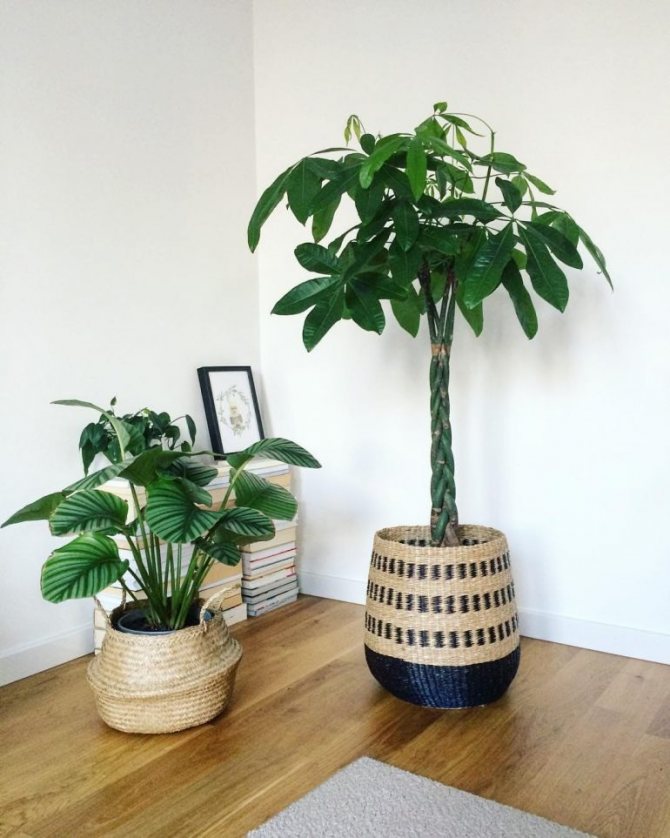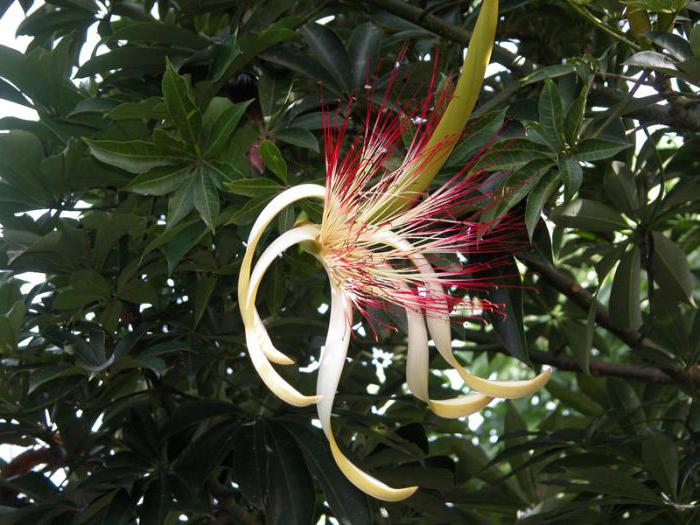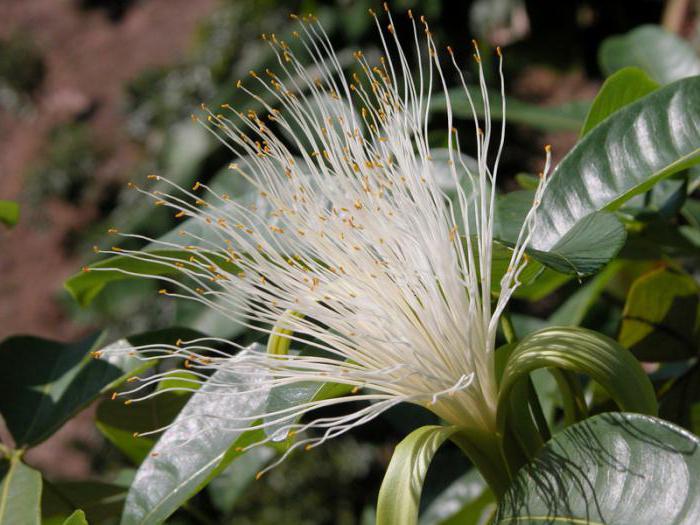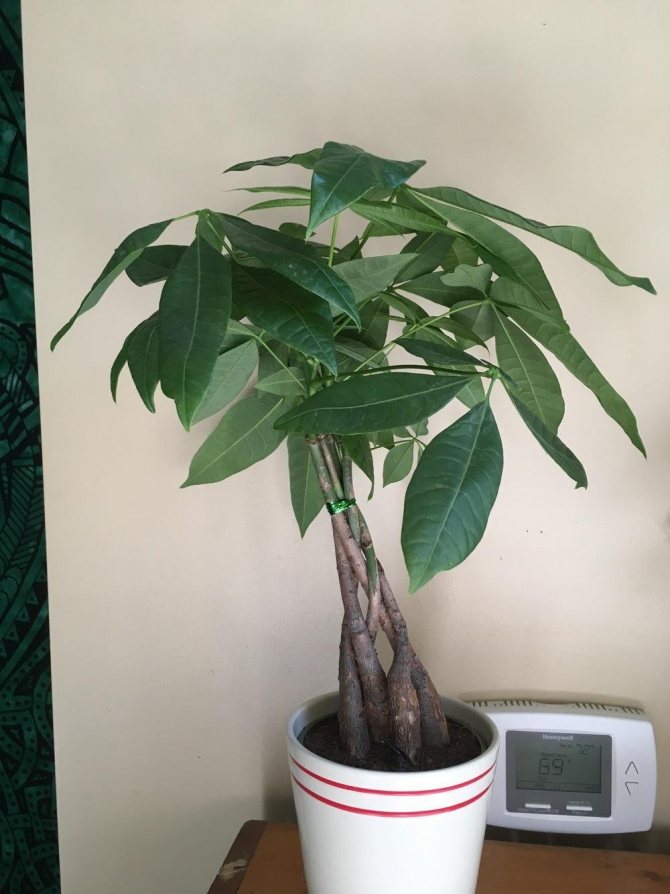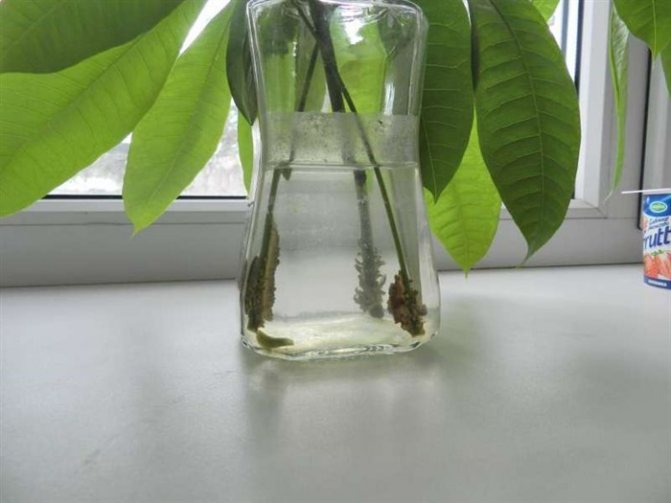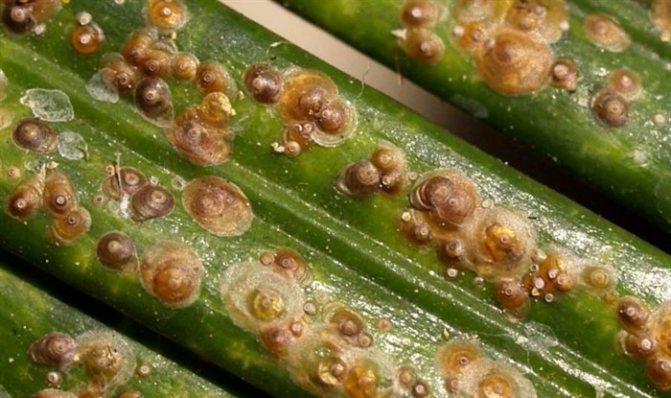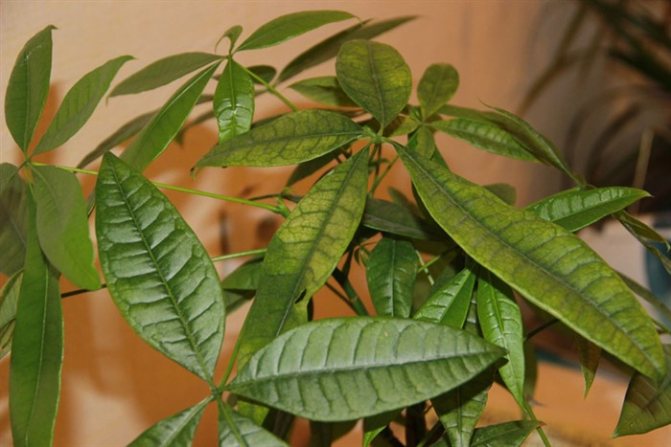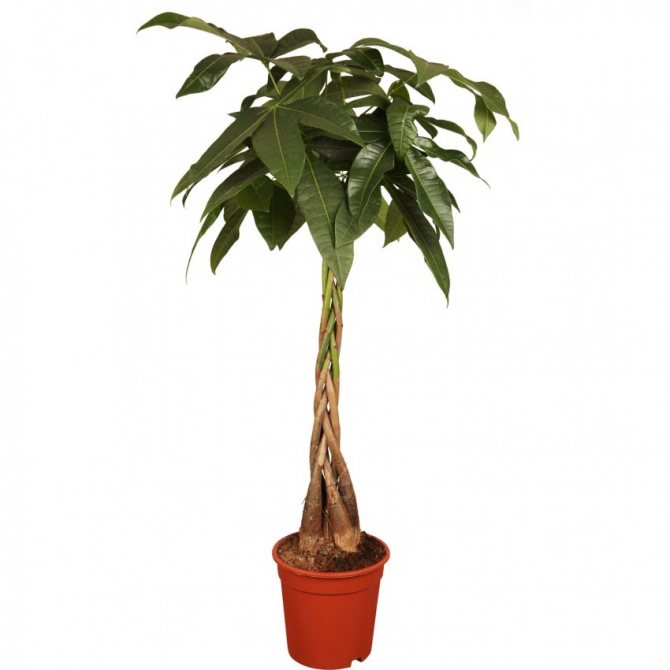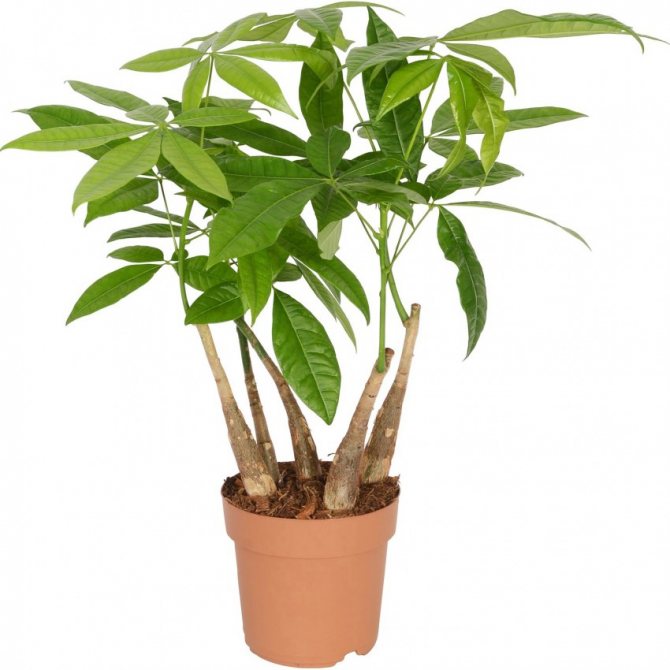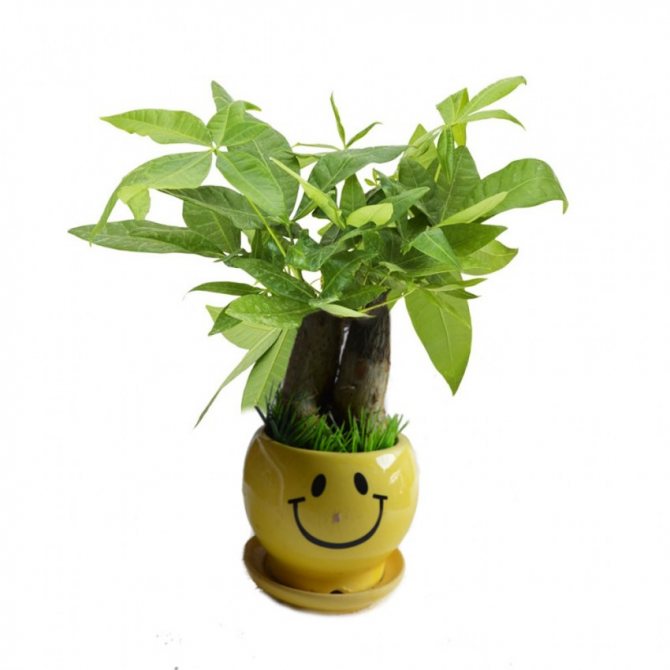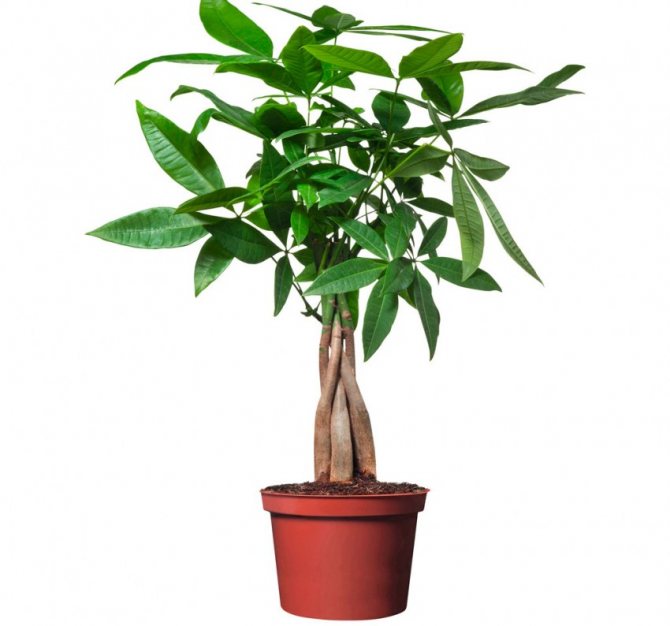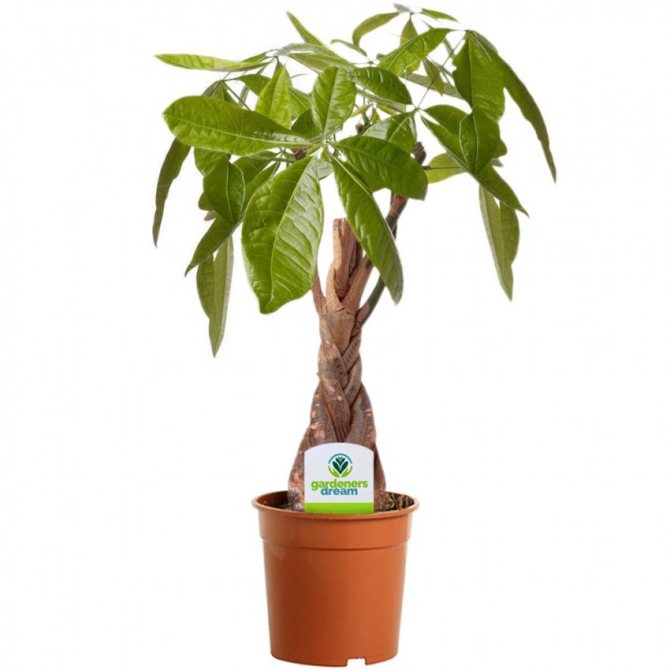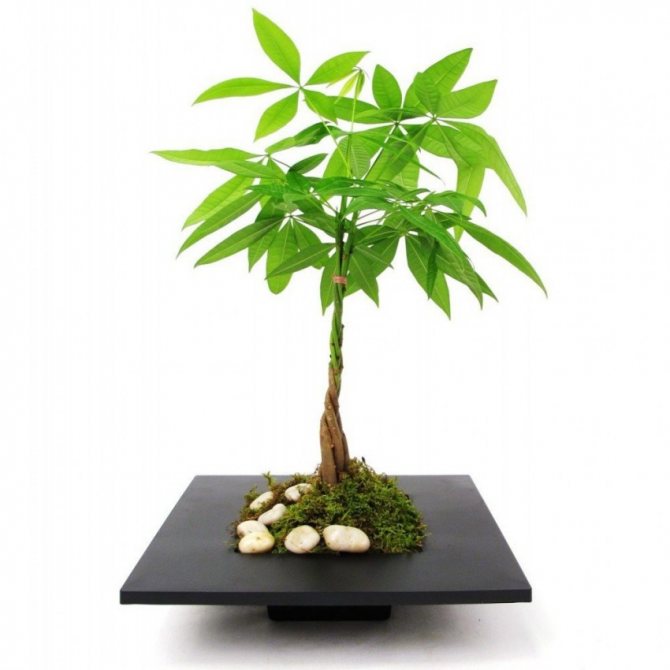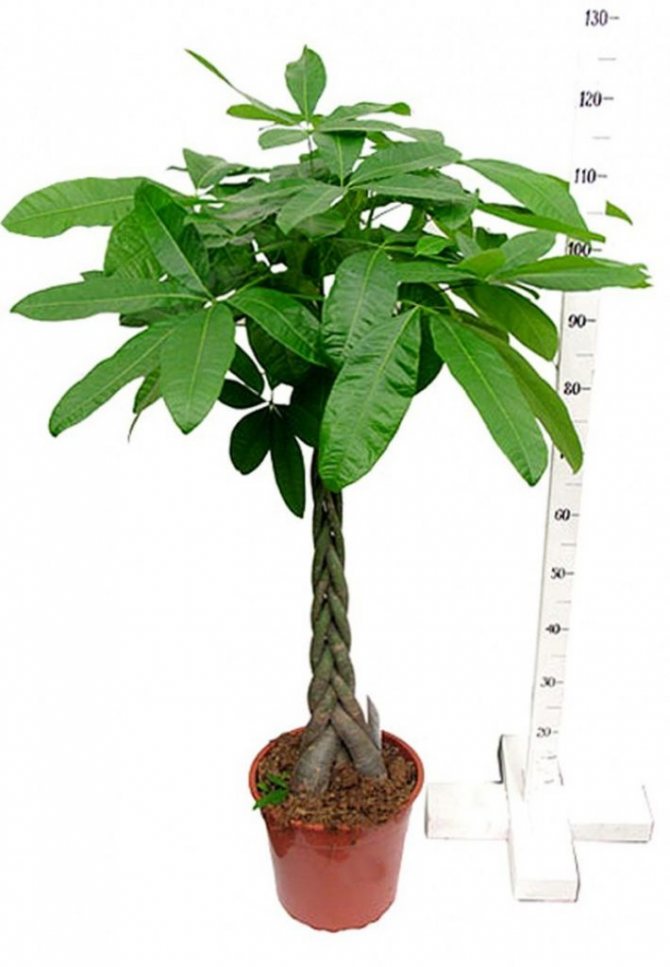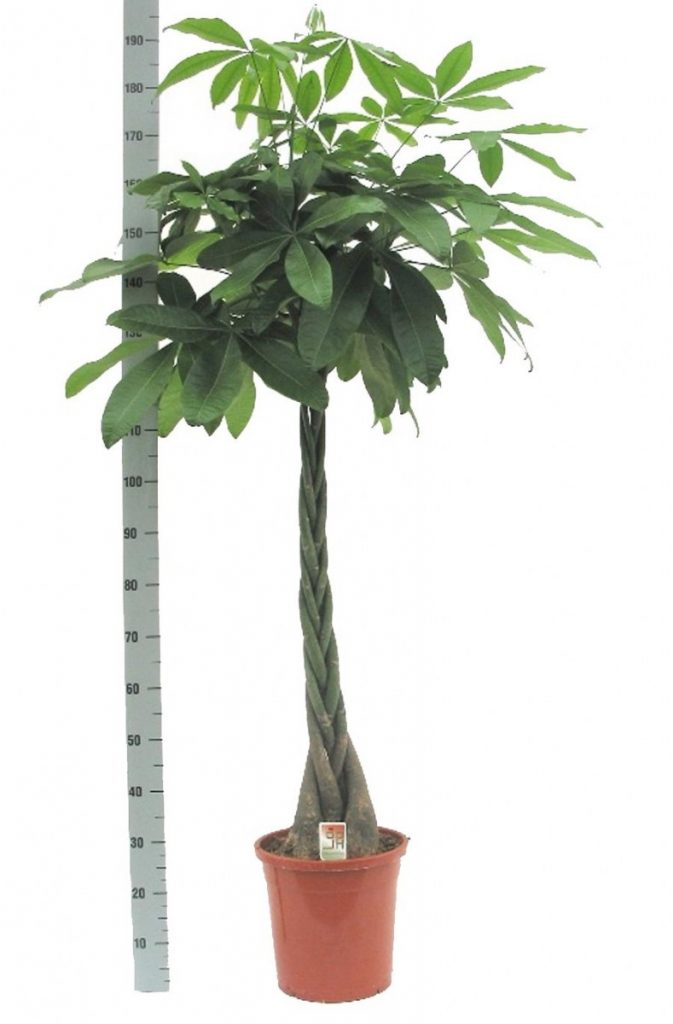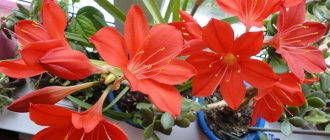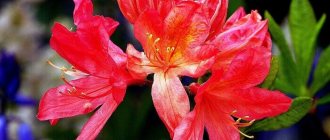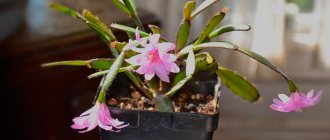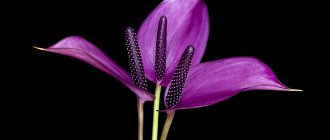Pachira (Pachira) is a plant of the baobab family originally from Mexico, its second name is Guiana chestnut or saba nut. From Latin Pachira translates as "plump", because it has a solid hollow trunk expanding to the roots, capable of retaining moisture. The top of the trunk is narrow, framed by a crown of smooth green leaves.
The size of the plant varies depending on the conditions of stay, so - at home, pakhira develops slowly and its maximum length is no more than three meters.
In its natural environment, pakhira can reach a height of up to 20 meters, and also produces flowers with multiple long stamens, after which greenish edible fruits ripen. In a home environment, the plant does not bloom or bear fruit, but its life expectancy with proper care can be about ten years.
Pakhira is grown not only as an ornamental plant. Its bark is used in folk medicine to relieve sore throat and stomach pain. The fruits of this plant are used in cooking - they are fried, bread is baked from ground "nuts", and hot drinks are prepared. In addition, pakhira is a symbol of abundance in the home. It is believed that with the growth of this plant, prosperity and good luck come to the family.
| High growth rate. |
| In a home environment, the plant does not bloom. |
| The plant is easy to grow. |
| Perennial. |
Botanical characteristic
Pakhira looks like a palm tree, in the wild the tree grows up to 20 m, at home - only up to 3 m. There are related cultures - baobab and durian.
Description:
- the barrel has a thickening at the bottom for the accumulation of nutrients and water, similar in appearance to a bottle,
- the leaves are bright green, the surface is glossy, shiny, the structure is leathery, attached on long petioles, with a finger-like complex shape similar to chestnut;
- the flowers are medium, collected in a paniculate inflorescence about 15-35 cm long, the flowering is white with a yellowish tinge, the stamens are bright pink, the smell is vanilla;
- fruits are green, oval shape, length up to 25 cm, can hold up to 25 pcs. nuts, seeds are edible raw and fried, are used in the bread industry for the production of flour and baking bakery products.
There is no flowering in the artificial environment.
According to signs and superstitions, pakhira brings happiness to the house.
Description
This plant is grown like a tree. At the same time, it belongs to succulents, because it stores moisture in reserve and stores it in the trunk under the bark. Its barrel resembles a bottle. Therefore, pakhira is called the bottle tree. There are other names: Malabar or Guiana chestnut, which the plant received for the similarity of the fruits and especially the leaves of chestnut and pakhira. At home, you can grow a specimen up to one and a half meters high. Pakhira aquatica, the photo of which is located below, has dark leaves. Their shape is finger-like, they are dense to the touch, leathery. The leaf petioles are long.
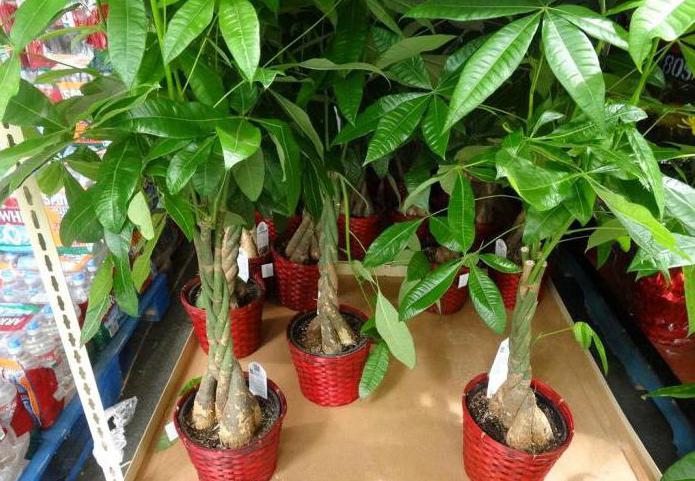
The homeland of pakhira is the swamps of Mexico. Under natural conditions, pakhira aquatica blooms every year from June to November. The flower is large, can be white, yellow, pink and cream. Its size reaches 12 cm. It has a large number of long stamens. The flowers have a vanilla scent. They are collected in panicle inflorescences. The length of each of them is 35 cm.The plant blooms with leaves, while other bottle trees do with fallen leaves. When grown in an apartment, it does not bloom.
Varieties
In domestic cultivation, several varieties are best known.
- Water. Also called aquatica, water, water chestnut. The classic representative of pakhira. Height about 3 m, crown diameter up to 1.5 m. Growth growth is slow.
- Silver. Similar to aquatic, but differs from it in a silver striped pattern on the leaves.
- Round-leaved. It is rare at home. The ampel variety is more often used in decorating office premises. Differs in long leafy shoots and a round shape of leaf plates.
Growing errors


With good care, the plant almost does not get sick
Most of the ailments of the plant are associated with mistakes in caring for it, as well as incorrectly organized growing conditions:
| Consequence of error | Cause | A way to correct the situation |
| Dry spots of a light shade on the leaves | Burn from direct sunlight | During strong sun activity, the plant is hidden behind a curtain or a special partition is installed |
| Brown edge on the edges of the sheet plates | Dry microclimate / susceptibility to drafts | In the summer, the tree is systematically sprayed / cleaned in a place protected from drafts |
| Loss of saturation by leaves, crushing | Lack of light | The cache-pot is rearranged from the depth of the room closer to the window opening |
| Leaves turn yellow and fall off | An incorrectly selected deep pot, as a result, excessive waterlogging. Also, the flower sheds foliage due to dry air coupled with high temperature. | Transplanted into a suitable planter / removed further from the batteries |
| Loss of turgor, gradual or active wilting | Lack of moisture and an excessively long interval between waterings | Irrigate so that the entire earthen lump is completely saturated with liquid |
| Leaves curl, turn brown along the outline | Temperature fluctuation | When a pot with a flower is located on the street, subject to significantly different night and day indicators, the plant is brought into the room in the evening |
Purchase and adaptation
The best time to buy is spring. When choosing a plant, you should pay attention to its appearance. A healthy flower:
- rich green foliage;
- no damage to the trunk and roots;
- there are no spots on the sheet plates.
The average price is 700 rubles.
After the purchase, the pakhira is sent to quarantine for 2 weeks, and then transplanted:
- get out of the pot, shake off the excess remnants of the earth;
- the roots are immersed in water for 15 minutes to wash off the soil;
- the root system is examined for the presence of rotten areas, the damaged fragments are cut off;
- the pot is chosen 2-5 cm in diameter more than the area of the underground part;
- the bottom is covered with drainage, from above - with earth to the level of 2/3 of the height of the pot container, forming a cone in the central part;
- pakhira is placed on the hillock, the roots are straightened, the soil is poured, filling the voids.
How to propagate at home
Malabar chestnut propagates in two ways: cuttings and seeds. Cuttings are made from side shoots in summer. Place them in pots and root them. When propagated by seeds, they are germinated, and then the seedlings are planted in separate pots.
Did you know? Most Malabar chestnuts have five or six leaves on each stem. But sometimes there are those with seven leaves on the stem. According to legends, such a tree brings good luck.
Cuttings
The most common breeding technique is stem grafting. The best time is summer.
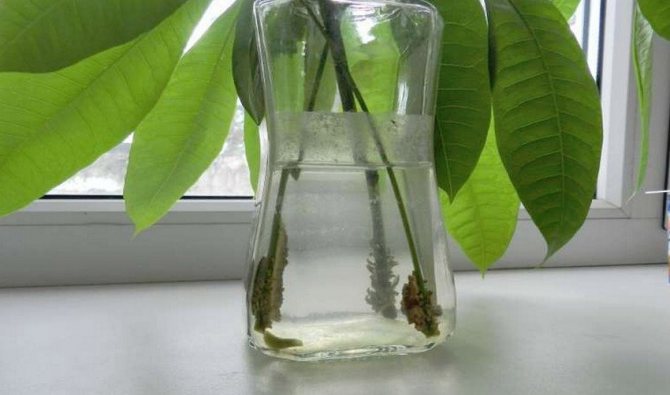

Instructions for propagation by cuttings:
- Cut a branch 10-15 cm long.
- Place it in water to germinate the roots.
- Place a container of water on a lighted windowsill. This will speed up root formation.
- Treat the roots with a growth stimulant.
- Prepare the rooting container. It can be a relatively small pot.
- Prepare the soil with a mixture of sand and sphagnum moss.
- Make a hole and plant a stalk. This must be done so as not to damage the roots.
- Water liberally.
- Compact the soil around the trunk.
- Place the pot on a windowsill with good lighting and an air temperature of + 21 ... + 25 ° С.
Did you know? Under natural conditions, the trunk of a pakhira does not braid by itself. This feature of appearance is formed by the one who grows this unique plant.
Seeds
Seed propagation is less common, but easier than propagation by cuttings.
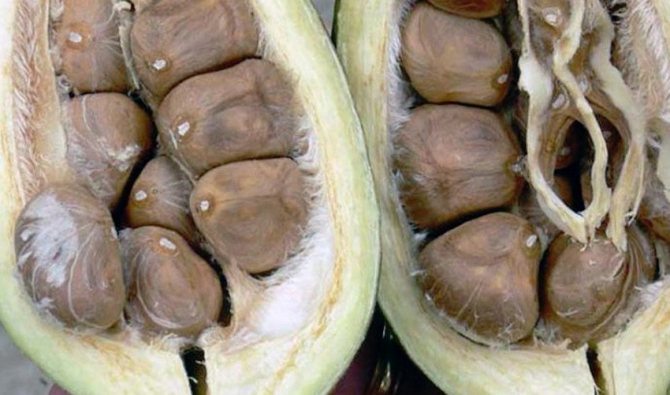

Step-by-step instructions for seed propagation:
- Start by soaking the seeds in water for 24 hours.
- Prepare a substrate from leafy soil and distribute the seeds evenly throughout.
- Cover them with about 1 cm of soil.
- Water liberally.
- Place in a bright and warm place.
- Seedlings should appear 3 weeks after planting.
Water at regular intervals throughout the germination period. And when the plants are big enough, place them in separate pots.
Important! The tree can grow unusually high
—
up to 23 m. To reduce its height for the room, twist the trunk.
Planting and transplanting
A shallow and wide pot is suitable for a houseplant. In too large a container, the risk of moisture stagnation and souring of the earth increases, which causes the appearance of fungal diseases.
The frequency of transplanting depends on the age of the flower culture:
- a young plant requires an annual pot change;
- adult pakhira (from 5 years old) grows without transplant for 3-4 seasons;
- for an old flower, they manage by changing the surface layer of the soil to a depth of about 5 cm.
The bottle tree is transplanted in the spring, around March-April. The best way is transshipment without replacing the substrate in order to avoid trauma to the roots.
Immediately after transplanting, in order to adapt to new conditions, the flower pot is placed for 2-3 days in a shaded place, the plants are not fed for 2 weeks from the moment of planting in fresh soil.
Using pakhira aquatica
In place of the pakhira flower, elongated large green berries are formed. Some sources call their pulp inedible. Others claim they can be eaten. Each fruit contains up to 25 nut seeds. The seeds can be eaten raw. They can be fried or cooked before eating. Also, the seeds are ground into flour, from which bread is baked. From the same powder, a delicious drink is prepared, like hot chocolate. Leaves and flowers are also eaten.
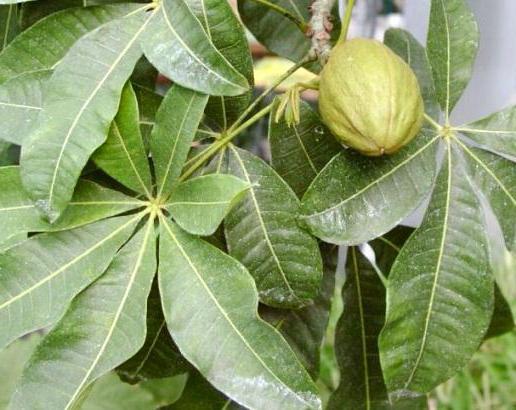

Pakhira plants are very popular. They are used to create bonsai. They are believed to bring good luck, health and well-being to the home. They should increase with each new sheet. The plant has the fame of a money tree. It is believed to bring good luck and prosperity.
The necessary conditions


Protect the flower from drafts
The most suitable place is the east or west window, where direct sunlight is observed only in the morning and evening hours. In summer, when located in a southerly direction, the plant needs shading from 12 to 17 hours. When placed in the northern part, it requires additional lighting.
In the summer season, taking out to the open air is shown Susceptible to drafts and overheating from heating appliances.
Under natural conditions, it grows on marginal lands. Mandatory requirements for the substrate are high air permeability and good drainage.
The recommended acidity level is neutral or low, but the plant can also grow in acidic and alkaline soils.
For planting, ready-made soil is suitable for growing decorative indoor deciduous and palm crops.Perlite or vermiculite is additionally added to it in an amount of about ¼ of the total volume of the mixture, which helps to increase the aeration of the soil layers.
You can make a soil mixture yourself by mixing in equal parts sod and leafy soil, coarse sand and brick chips.
Humidity
The culture is undemanding to humidity conditions, easily tolerates being surrounded by dry air, but responds well to spraying on foliage, which is why the aboveground part increases brightness. Frequency - up to 2 times a day, avoiding hitting the barrel.
Recommended rates are about 50-60%.
Temperature
The heat-loving tropical flower requires high temperatures. Optimal mode:
- in spring and summer - 22-25 ° С, an excess of 35 ° С leads to the termination of plant growth;
- in autumn and winter - 14-16 ° С, the minimum allowable limit is 6-7 ° С, at which foliage begins to fall, at 0 ° С the culture dies.
Lighting
Needs good lighting. With a lack of light, it loses its decorative effect: the leaves become pale, the stem stretches.
The optimal daylight hours are 10 or more hours. The lack of lighting in winter is compensated by the use of artificial light sources.
Regular rotation of the flowerpot 45 ° ensures even crown development.
Gardeners reviews
My pahira is already three years old. During this time, only once I had a problem, when the mother-in-law flooded the plant while I was on vacation. I had to start treatment and take urgent measures to save my pet, do an emergency transplant, pruning spoiled roots. Then I almost lost it, fortunately, I have a good experience of caring for plants and the Internet, of course ... I place the pakhira on the east window. The leaves of this flower do not tolerate direct sunlight very well. Never leave the pakhira on the south window or in the sun. The burnt leaves will dry out, brownish burn marks will appear on them and the leaves may even fall off. But in any case, the lighting should be sufficient. If the plant does not receive enough light, the trunk does not develop well and does not acquire the same colorful shape. Such a pakhira looks stunted and very sad.
Dragonfly
I can say that pakhira is a rather unpretentious plant, if you “tune in to its wave” and observe the regime. It is necessary to watch her as if she were sick - where she likes to stand (she does not like the direct sun, only scattered and half a day) - twisted leaves and the loss of chlorophyll is a scorching sun. The temperature is also an average of 25 in winter and summer, I can't stand it on the balcony. I rarely spray - when there are many plants nearby, it means that it is no longer too dry. Yellowed old leaves are normal, I still have old leaves with spots hanging, I do not touch them. I do not spray or water with any fungicides. I fertilize every week or two with a universal fertilizer with a lower dose. It grows, one by one it gives out a new leaf. An air conditioner is hanging nearby. So it's not hot. It can rot from the heat and attract insects.
frosty
I'll tell you about the features that I observe with my flower: 1. Pakhira loves loneliness. Next to the ficus, her leaves begin to turn yellow and fall off - and this is a sure sign that the pakhira is uncomfortable! But next to the lemon tree, pakhira feels very good, does not act up! 2. Pakhira is one of those water-saving plants that you can forget to water. Do not forget that pakhira is a tree, albeit small, she, like all trees, loves rain, that is, spraying. But he can live without them. I do not spoil my pakhira, I water it sometimes, and then thank God! 3. If you put pakhira in a dark place, it begins to grow in height faster. But not by the trunk, but such a thin-stemmed ugly tree is obtained. I cut these trunks about a meter, no less. Let my pakhira have a better beautiful fluffy crown.
Quantika
Care
Watering
The water should be settled, without chlorine, 2-3 above room temperature. Water the flower under the root, avoiding moisture on the trunk, or by immersion for 0.5-1.0 hours.
The immersion method is not used if the ambient air is less than 20 ° C or if the pakhira was recently transplanted.
The frequency of moistening depends on the rate of soil drying and is usually about 2-3 times a month in summer and up to times in a similar interval in winter.
The plant is able to withstand short-term drought, consuming water accumulated in a thick trunk, therefore the main rule that should be followed when organizing watering procedures is to underfill rather than overfill.
Top dressing
Pakhira is fed from the beginning of spring to the onset of autumn, when active growth is observed. For the winter, feeding is canceled.
Ready-made universal fertilizers intended for indoor plants are suitable for nutrition (the dosage is halved).
Often, root dressing is combined with watering: half of the volume is watered) the plant, the second part is mixed with the nutrient composition.
Trimming and shaping
The plant can be shaped in different ways.
For decorative purposes, the flower culture is cut in the spring. When pruning, strongly elongated shoots that stand out from the total mass are subject to shortening, which are subsequently taken for reproduction. The shoots that have appeared on the trunk are also removed.
Due to its slow growth, pachira can be used to create a bonsai tree.
When planting several plants at once in a single pot, a trunk is formed in the form of a braid with a heel. For such a procedure, only young specimens with still non-lignified, flexible stems are suitable. It is better to braid the trunks more than once, but in several approaches, fixing at intermediate stages with a rope.
Plant pruning
Pruning of branches is carried out in the spring. In the place where the cut was carried out, the rapid growth of young branches begins, the crown becomes lush. With the help of trimming, you can shape the crown, giving it the desired shape, most often in the form of a ball.


You can shape the trunk of the pakhira so that it looks like a pigtail. To do this, three plants are planted in one pot at once and gradually weave them together. But this is not always possible. Sometimes, with this form of cultivation, only one trunk develops, while others or one of them lags behind in development or disappear.
Reproduction methods
At home, pakhira propagates by cuttings and seeds.
Seminal
Only high-quality seeds are suitable for sowing, preferably not so long ago extracted from the fruits after flowering. Due to their large size, they are planted immediately in separate containers - small pots or plastic cups.
A peat mixture of peat and sand (perlite) is prepared for planting in a ratio of 5: 3. The seeds are buried 1-2 cm, directing the light spot (eye) to the side. The sowing is watered and covered with plastic wrap or glass cover to create a greenhouse.
For successful germination of seedlings, the temperature is maintained at about 25 ° C-27 ° C.
As the seedlings emerge, the shelter is removed, organizing the airing and moistening of the soil from the spray bottle. The hardened sprouts can be rearranged to a permanent place when they have 3-5 leaves, providing them with care as for an adult plant.
Cuttings
- From the upper part of the lignified shoots, shoots up to 15 cm long with well-developed 3-5 leaves are chosen.
- They are rooted in peat and coarse sand mixed in equal proportions.
For fast rooting, you need to create greenhouse conditions and maintain high humidity, and stimulants are also used.
It takes 4-6 weeks to root the cuttings, after which it is necessary to care for it like an adult flower.
How to deal with pests - table
| Pests | Damage | Control measures |
| Spider mites | Small purple insects.As a result of their attack, the leaves turn yellow and become covered with cobwebs. |
|
| Shields | When the scabbard sticks to the leaf, a yellow spot appears there, gradually increasing. The leaf turns yellow, curls and falls off. | The insect is covered with a "shield", so spraying is almost ineffective. You need to collect pests by hand: moisten a napkin in a solution of Aktara or Karbofos preparations and thoroughly wipe all the leaves. |
| Aphid | Small insects (like white droplets). They feed on the sap of the leaves. Leaves sticky marks. |
|
| Thrips | Small insects with a narrow elongated body and wings. They leave traces - small dark dots. They destroy leaves, are carriers of viruses and diseases. |
|
Pakhira pests - photo
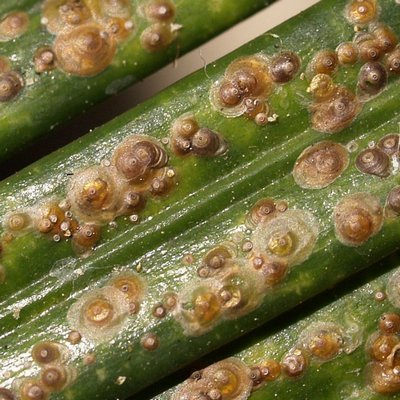

Severe damage to scabbards can cause the death of the plant.
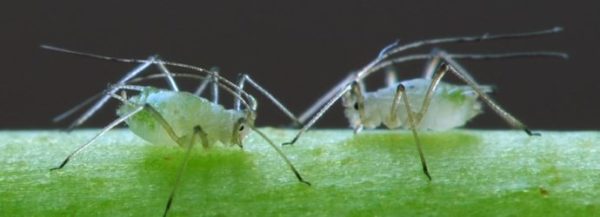

Aphids feed on leaf sap and leave sticky marks.
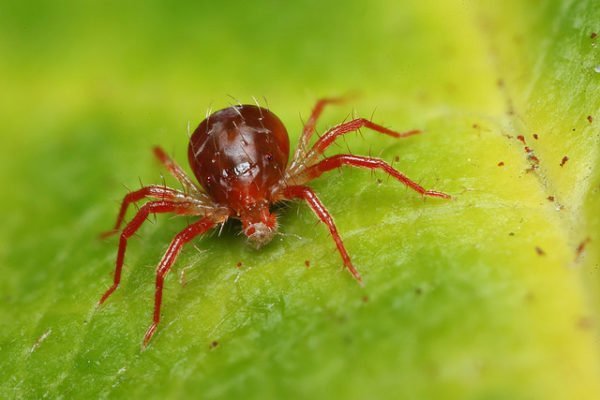

A tick entangles a plant with a web


Thrips destroy leaves, carry viruses
Treatment of diseases and pests
Dry air is undesirable for pakhira. under such conditions, the risk of a spider mite appearing on it increases. Other pests include mealybugs and scale insects.
Separate changes in appearance, illness and loss of decorativeness of an indoor flower are often caused by a violation of care.
| Type of defeat | Control measures |
| Spider mite. Signs - the appearance of white dots (puncture sites) and cobwebs on the foliage. | Increase the humidity in the room. The plant is given a warm shower and treated with insecticidal preparations, for example, Aktellik and Aktara. |
| Mealybug. Its appearance will be prompted by whitish cotton raids in the leaf axils and on the stems. | Harmful insects are collected by hand by wiping the vegetative mass with soapy water (50 g per 1 water). In case of mass infestation, the flower culture is sprayed with a suitable insecticide, for example, Aktara, Confidor, and the substrate infected with larvae is replaced with a fresh one, having previously disinfected the pot. |
| Shield. Leaves a waxy coating on foliage and shoots. | Control measures are similar to the way to get rid of mealybugs. |
| Leaves turn yellow and fall. Caused by prolonged exposure to dry air and lack of nutrition. | An indoor flower is sprayed over the foliage. In winter, the humidity is increased with air humidifiers or in other suitable ways. They are brought in according to the timing of feeding. |
| Dry foliage. Appears more often when getting sunburn. | The flowerpot is rearranged for the first time in a shaded place, then under diffused light. In the absence of the possibility of permutation, shading is provided. |
| Brown spots on the leaf blades. Tips dry. The first sign of a lack of water. | Watering is normalized with alternating sprays on foliage. |
| Loss of turgor by the leaf mass. It is a consequence of overflow. | Reduce watering. The flooded flower is transplanted into a fresh substrate. |
| White bloom with a fleecy structure on foliage. Powdery mildew symptom. | The plant is sprayed with a fungicide, for example, Skor, Topaz, after cutting off the damaged areas. |
| The flower sheds withered and yellowed leaves. Serves as a symptom of the development of a fungal disease - root rot due to stagnant water. | The root system is examined, the rotten fragments are cut off, the survivors are treated with a weak pink solution of potassium permanganate or a fungicide. The substrate is changed to a fresh one, after having disinfected the pot. |
Care errors and ways to correct them, treatment - table
| Problem | Cause | Solution method |
| Leaves wither | lack of water | Increase watering. |
| Leaves shrink and become faded | lack of light | Move the plant to a well-lit place. |
| The plant is stretched | ||
| Light spots appear on the leaves | excess light | Rearrange the plant in partial shade or shade. |
| The leaves became soft and curled | low room temperature (or large differences between day and night) | Increase the temperature or move the plant to a warmer room. |
| Brown spots form on the leaves | lack of watering, drafts or low air humidity | Eliminate drafts, adjust humidity and watering. |
| The trunk is rotting | excess moisture in the soil |
|
| The trunk is soft, not bouncy | decay of the trunk or roots | |
| Leaves fall | pot too spacious for a plant | Transplant the pakhira into a smaller container. |
| lack of nutrients | Feed. |
Top dressing
Pakhira does not require any special nutrient soil. It can be fed only during active growth (in spring and summer) once a month with complex mineral fertilizers of a low concentration.
The soil
The land for a plant like Pakhira should include leafy land, turf land and sand, taken in equal proportions.
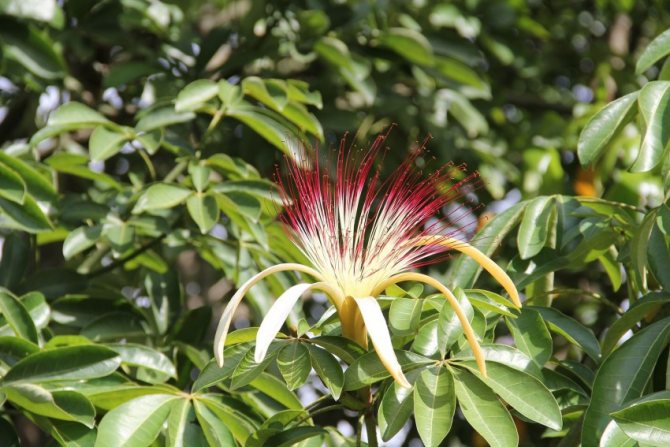

If you buy a mixture, it is better to take the same as for palms or dracaena. Be sure to add a drainage layer to the bottom of the vessel, which occupies about 30% of the volume of the pot.
Photo
Visually familiarize yourself with the flower Pakhira Aquatika you can on Photo below.
Trimming the pachyra and shaping the trunk-pigtail
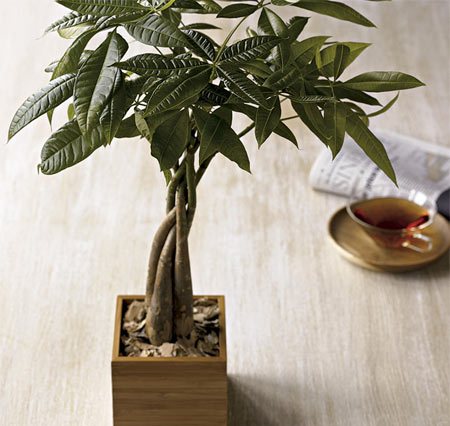

Bonsai from pachira photo
To form a beautiful lush crown, it is necessary to trim the crown. This is done in the spring, when the branches grow and get stronger enough. New shoots will appear at the cut sites, making it possible to create the desired shape.
It is imperative that when root suckers appear, they must be removed in order to maintain the formed shape of the trunk and prevent the plant from weakening in the future, when it will be problematic to cut off the grown lateral shoots.
How to braid pakhira
Several plants, intertwined with trunks, look very impressive. To obtain such beauty, it is necessary to plant 3-4 cuttings of the same height in one container. Twist them with a pigtail or wrap them in a spiral, pull the top with twine so that the shoots do not disperse. It is important not to overtighten: if the trunk is damaged, sap flow will be disrupted and the plants will die.
Over time, the stems will take on a given shape and continue to grow. Prune the leaves as they grow and continue curling, but do before the stems are lignified. If you remove the bark at the points of contact of the trunks, they will grow together and will look even more harmonious.
Signs and superstitions, feng shui pakhira
Folk signs say that a pakhira living in a house cannot be passed on to someone or given as a gift. If this is done, then in the future the rest of the flowers stop growing and blooming. But, if for some reason the plant still needs to be given away, then it is necessary to take some thing or at least a coin from the new owner.


Feng Shui theory believes that pakhira endows households with health, luck, wealth and prosperity... Moreover, after the appearance of the next young leaf, there is an increase in all these benefits.With the appearance of this plant in the house, positive energy rises, and the negative one sharply weakens, which creates a friendly atmosphere in the family.
1. Seven Secrets of Success:
| 1. Growing temperature: summer - 18 - 24 ° С, winter - 10 - 15 ° С. Pakhira needs a cool dormant period only in case of insufficient illumination in autumn and winter. |
| 2. Lighting: shade from direct sunlight, direct sunlight in the morning and evening in spring and summer. In autumn and winter, bright lighting throughout the day. |
| 3. Watering and humidity: regular watering in spring and summer with drying of the upper layer of the substrate a few centimeters deep. In autumn and winter, watering is minimized, simply protecting the soil from completely drying out. Air humidity increases with the onset of warm weather. |
| 4. Features of the: Pakhira is an extremely attractive plant that can be easily grown at home with minimal maintenance. |
| 5. Priming: the main requirement of the flower is that the substrate must have excellent drainage, the plant tolerates well even nutrient-poor soils. |
| 6. Top dressing: during the entire growing season - mineral fertilizers or organic matter every 2 weeks. In the fall, feeding is reduced, and in the winter it is stopped altogether. Fertilization is resumed in the spring when young leaves appear |
| 7. Reproduction: apical cuttings in early spring, sowing seeds. |
Botanical name: Pachira.
Pachira flower - family... Malvaceae.
Origin... Mexico South America.


Description... Pakhira is a fast growing evergreen wood with slender, thin, flexible trunkscovered with thin light brown bark. At the base of the trunks there is often a thickening, which gave the second name to the plant - “bottle tree«. Stems pakhirs rarely branch out.
Leaves complex - consist of 5 - 6 oblong-oval leaves of dark green color, located on long, thin petioles, form a crown in the upper part of the plant. Another name is “malabar chestnut“, Just given for the shape of the leaves, reminiscent of chestnut leaves. Each leaf can be up to 30 cm in diameter.
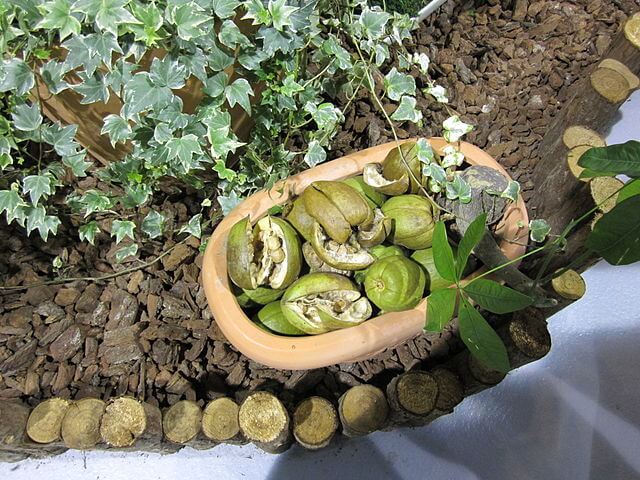

Flowers attractive, white, yellow or greenish, with long, narrow petals, reaching a diameter of 15 - 20 cm. The main decoration of the plant is long, straight stamens, painted white with pink or red tips.
The flowers have a pleasant aroma that intensifies at night. The aroma of pakhira is reminiscent of vanilla.
After flowering, the plants form edible fruitthat taste like peanuts.
Currently, there are copies on sale with beautifully intertwined trunks.
↑ Up,
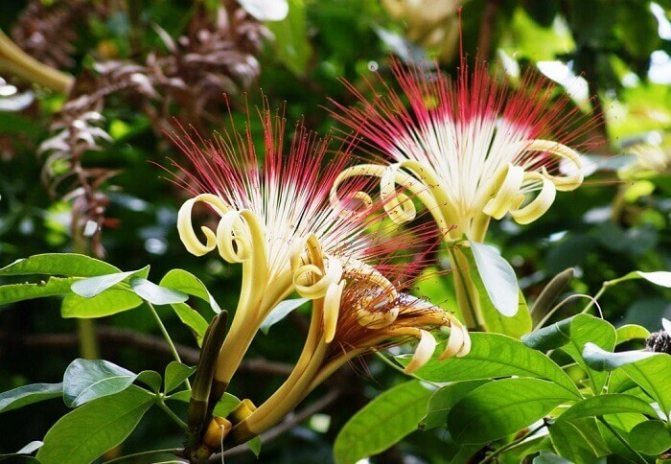

Height... Pakhira at home growing rapidly and quickly reaches impressive sizes.
In a room culture, mainly young plants are kept, the height of which can be adjusted by planting in a tight pot and pruning.
In nature, pakhira reaches height 20 m.
↑ Up,
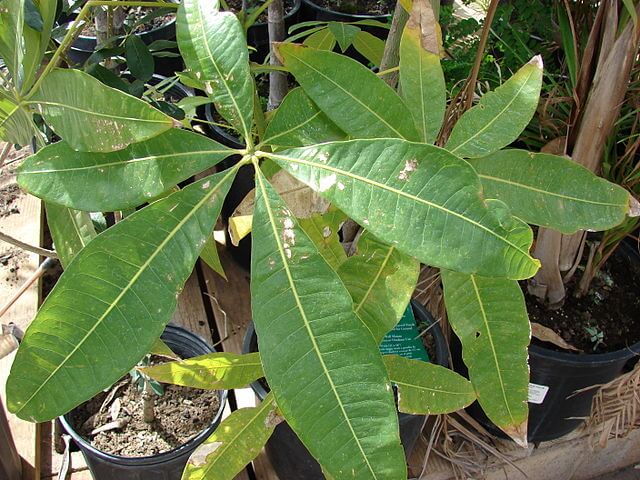

You may also be interested in:
- Dracaena - photo, home care, types, reproduction, transplanting room dracaena, watering the plant, flowering, pruning, diseases and pests
- Nolina - photo, home care, growing a bottle tree from seeds, transplanting bokarnei, a pot for growing, why nolina dries, reproduction
- Nertera or coral moss - photo, home care, planting in open ground, description - what it looks like, reproduction - rooting cuttings and growing from seeds, watering and feeding, soil composition, lighting
- Scindapsus - flower photo, scindapsus care at home, types of indoor plants, signs, flower reproduction, soil for growing, flowering
↑ Up,
Growing pakhira from seeds
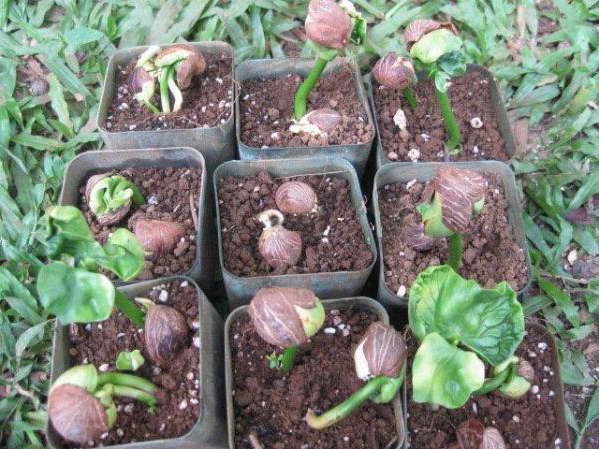

Pakhira from seeds photo shoots
Pakhira is propagated by seed and cuttings.
Seeds lose their germination quickly, so sow fresh.Take a container with a peat-sand mixture, moisten the soil, spread the seeds on the surface and sprinkle a little with earth. Cover crops with glass or transparent film. Maintain the air temperature at 25-30 ° C. Ventilate crops daily, spray the soil periodically. Expect shoots in 20 days. Fortified young plants without picking are transplanted into separate pots with soil for adult specimens.
Alarms
The tips of the leaves darken and the tree sheds them - most likely this is caused by poor watering with increased dry air. The tree may throw off its leaves if the pot it chose when replanting is too wide. The temperature difference between day and night leads to leaf curling.
A soft and sluggish trunk is an indicator that root rot is likely to occur. The plant is freed from the old soil, the roots are checked, the diseased or dead are removed and planted in new soil. Dry light spots appeared on the leaves - these are traces of sunburn.
Recommendations
Do not be afraid to dry out pakhira in the autumn-winter period. Water consumption at this time is reduced by about 3-4 times. In addition, the plant is adapted during dry periods to consume moisture, which accumulates in the cavity between bark and wood.
- The domestic pachira flower belongs to the "bottle trees". They store water in the thickened part of the stem. Make sure that the trunk of the pachira is elastic.
- Pakhira, like the fat woman, is often called the tree of wealth. It is recommended to place it in the part of the house, which, according to Feng Shui, symbolizes the attraction of money.
- It is important to remember that when transplanting, the plant must not be buried below the level at which it grew before transplanting. Compliance with this rule will save the roots from decay and will delight the owners with another decorative quality - stilted roots protruding beautifully above the ground, which thicken over time. Due to this property and the flexibility of young shoots, pakhira is sometimes formed into bonsai. But more often the trunks are braided into spirals and braids while still young. Over time, this technique gives the plant a very spectacular look.


In the autumn-winter period - the period of relative dormancy of the plant, which is manifested by slowed down metabolic processes, there is a risk of stem decay from excess soil moisture. When rot appears in the pakhira, the leaves turn black, and the stem becomes soft. As soon as alarming symptoms are noticed, you need to remove the plant from the container, carefully shake off the waterlogged soil, inspect and remove the decayed parts of the plant.
You also need to treat the cut points with a sorbent (crushed coal) and plant in a fresh substrate. At first, it is necessary to significantly limit watering, giving the soil substrate the opportunity to dry well. The amount of water during irrigation should be such that the moisture completely soaks the lump, and a small amount of water passes to the sump.
Views
- Pakhira aquatica (water, or Malabar chestnut)). The only species that can be successfully grown at home. But in indoor conditions it does not bloom. Bright green glossy foliage perfectly purifies the air. The fruits are edible and taste like peanuts. It is recommended to start this type of pakhira for those who suffer from neuroses and insomnia.
- Pakhira is silvery. The shape of the leaves, the size is similar to the aquatic pachira, but on the surface of the leaves there is a silvery pattern, which makes this variety especially attractive.
- Pakhira is round-leaved. A rare species with rounded leaves, branches spread. Used as ampelous.
General information
INTERESTING. According to the Taoist practice of Feng Shui, pakhira fills the room with a healing aura. And five leaves on the shoot symbolize the five elements. Therefore, the Japanese carefully look after the plant, and they are very happy with the appearance of each new “element”. After all, this means financial prosperity and well-being in all areas of life.In order not to block the cash flow, the plant should not be placed on the north window.
The homeland of this exotic is the central and southern tropical forests of America. There, the plant can reach 20 meters. At home, the height of the plant is limited by the ceiling, but it is usually cut and pinched to form a round or oval shape. It grows very slowly. One of the main “decorations” is an unusual “bottle” barrel. In its lower part, water and nutrients accumulate, which provides such a form. The specimens look very unusual when several pakhirs are planted in one pot, and their trunks are intertwined in an elegant "pigtail". This is a rather long and laborious process, so the cost of such plants is usually very high.



